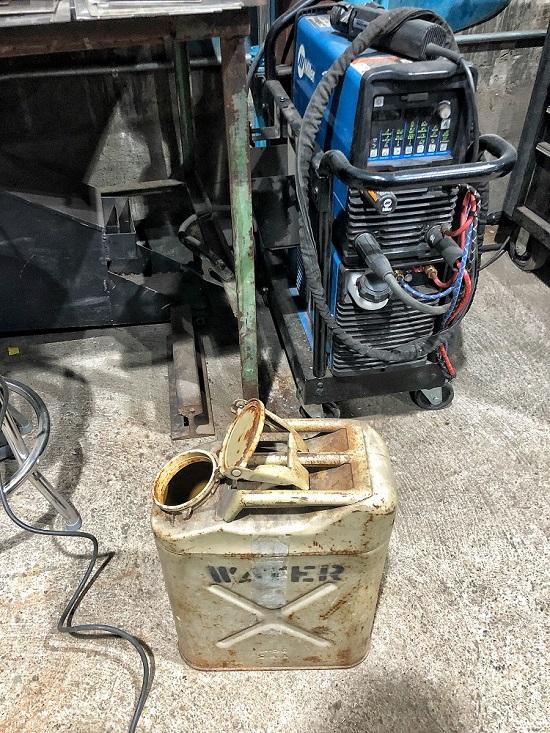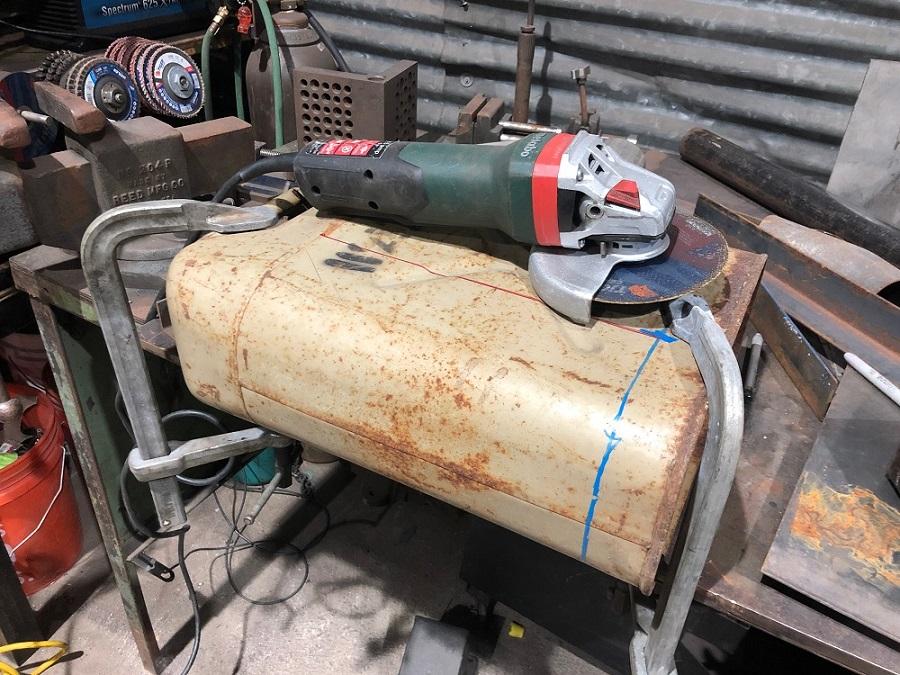Owner, Brown Dog Welding
- FMA
- The Fabricator
- FABTECH
- Canadian Metalworking
Categories
- Additive Manufacturing
- Aluminum Welding
- Arc Welding
- Assembly and Joining
- Automation and Robotics
- Bending and Forming
- Consumables
- Cutting and Weld Prep
- Electric Vehicles
- En Español
- Finishing
- Hydroforming
- Laser Cutting
- Laser Welding
- Machining
- Manufacturing Software
- Materials Handling
- Metals/Materials
- Oxyfuel Cutting
- Plasma Cutting
- Power Tools
- Punching and Other Holemaking
- Roll Forming
- Safety
- Sawing
- Shearing
- Shop Management
- Testing and Measuring
- Tube and Pipe Fabrication
- Tube and Pipe Production
- Waterjet Cutting
Industry Directory
Webcasts
Podcasts
FAB 40
Advertise
Subscribe
Account Login
Search
Fabricating the jerrycan into a “jerrystove” – Part I
Why an old military liquid steel container works perfectly to create a unique rocket stove
- By Josh Welton
- March 27, 2019

Josh Welton took on a project to turn a jerrycan into a rocket stove, something he's calling a "jerrystove."
Now that we’ve re-emerged from the plethora of dark and twisted tunnels that make up the history of the “jerrycan” (Part I and Part II), we can finally move on to what started that tangent: the “jerrystove.”
Throwing stuff away isn’t my style. I don’t think “hoarder” is the proper description, but I do collect a lot of junk. Some of the stuff just looks cool sitting in the loft: a traffic light, a couple of whiskey barrels, an old school brass fire extinguisher. Other unique pieces are most definitely destined to become part of a sculpture: an old snow shovel scoop, a test lid from a Miller welder, a door from a ’68 Dodge Coronet. Then there are a couple of things that sit in the middle; they kind of look neat just hanging out. But if the right idea hops into my brain, perhaps they might be of use in a project.
This jerrycan has sat in the middle for a long time, ever since Darla’s great-uncle Paul gifted it to me seven or eight years ago. This one had “WATER” painted in big letters on both sides and “19.95” on the back, which I assume meant it did some time waiting for a new owner at a garage sale. In my shop it just blended into the background with that neat military look and earned patina.
It’s no secret that I enjoy playing with fire. So, when I started seeing rocket stoves pop up in my social media feeds, they caught my attention.
What is a rocket stove?
Here’s how it’s commonly defined:
“A rocket stove is an efficient and hot burning stove using small-diameter wood fuel. Fuel is burned in a simple combustion chamber containing an insulated vertical chimney, which ensures almost complete combustion prior to the flames reaching the cooking surface. Rocket stove designs are most often used for portable stoves for cooking, but the design is also used for large fixed stoves in institutions, and to make rocket mass heaters for heating.”
So how do you differentiate a rocket stove from a typical stove or furnace?
The definition goes on to explain:
“The main difference between a normal fireplace or woodstove and a rocket stove is that rocket combustion is close to complete. When wood is burned it releases volatile compounds that we recognize as smoke or soot or creosote. In a rocket stove these compounds are sucked into the insulated and very hot ‘burn tunnel’ of the unit where they combust, releasing even more heat energy to drive the rocket process, unlike a normal fire where they are blown out the chimney.”
Why the “rocket” terminology?
Here’s how permacultureprinciples.com describes it:

Josh Welton had an old military jerrycan laying around his shop and decided to fabricate it into a rocket stove.
“This distinctive sucking of the flames down into the burn tunnel, and the resultant ‘roar,’ is what gives rocket stoves their name. This is also a part of their magic. Rocket stoves are open where the wood is fed in, allowing lots of oxygen to be drawn into the unit. As the fire starts, and the burn tunnel heats up, the rising hot air races up the heat riser, drawing lots of air behind it. This incoming air flows into the feed tube and across the burning wood – creating the same effect as pointing a big air-blower at your fire. It gets really hot, the wood burns beautifully, and you hear the air roaring as it charges through the system.”
At some point I thought it would be cool to make one. We don’t have room to keep a grill at our place, but we would have room for a small rocket stove. It would have to be small enough to easily tuck away and light enough to carry.
And, of course, I can’t ever just go with the norm; I needed to make mine unique. Sitting out in my shop, looking at that old jerrycan, everything clicked. I could use the can as the base from which to build the stove. There would be an inner chamber made mostly of stainless. Also, the space between the chamber and the walls of the canister would provide insulation. I would fabricate a grill to set over the top of the chimney for when we cooked. The spout would open to accept wood, a tray would pull out to remove ashes, and a tube would run from the outer wall into the burn chamber for airflow.
There are sites and forums dedicated to the art of building a rocket stove. I did a little light reading, but mostly decided I’d build one and tweak it as I found its weaknesses.
So, it began. No blueprints or even a sketch, just the fuzzy image in my mind’s eye of what I wanted it to be.
Step 1: Break out the Metabos.
To be continued …
Check back next week for Part II of the “jerrystove” project.
subscribe now

The Welder, formerly known as Practical Welding Today, is a showcase of the real people who make the products we use and work with every day. This magazine has served the welding community in North America well for more than 20 years.
start your free subscriptionAbout the Author

About the Publication
- Stay connected from anywhere

Easily access valuable industry resources now with full access to the digital edition of The Fabricator.

Easily access valuable industry resources now with full access to the digital edition of The Welder.

Easily access valuable industry resources now with full access to the digital edition of The Tube and Pipe Journal.
- Podcasting
- Podcast:
- The Fabricator Podcast
- Published:
- 04/16/2024
- Running Time:
- 63:29
In this episode of The Fabricator Podcast, Caleb Chamberlain, co-founder and CEO of OSH Cut, discusses his company’s...
- Trending Articles
Sheffield Forgemasters makes global leap in welding technology

ESAB unveils Texas facility renovation

Engine-driven welding machines include integrated air compressors

How welders can stay safe during grinding

The impact of sine and square waves in aluminum AC welding, Part I

- Industry Events
16th Annual Safety Conference
- April 30 - May 1, 2024
- Elgin,
Pipe and Tube Conference
- May 21 - 22, 2024
- Omaha, NE
World-Class Roll Forming Workshop
- June 5 - 6, 2024
- Louisville, KY
Advanced Laser Application Workshop
- June 25 - 27, 2024
- Novi, MI



























